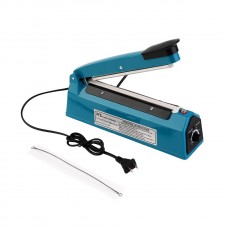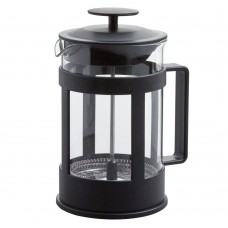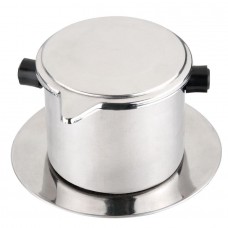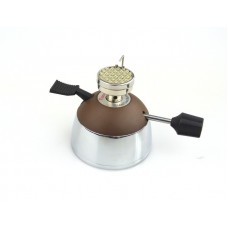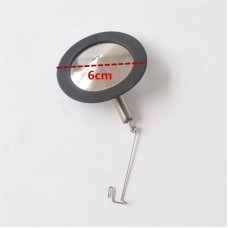Coffee Storage & Brewing

Storing Coffee:
If storing coffee at or about room temperature, roasted coffee (beans or ground) should be stored in an airtight bag that also has a one-way valve that allows the “out-gassing” of the CO2 that roasted beans can give off. Freshly roasted beans that are placed in an airtight bag, without such a valve, can actually burst the bag from a buildup of gas pressure inside. Green beans that are not frozen, must “breathe”, so they are stored in a heavy (Kraft) paper or burlap type bag.
Refrigerator/Freezer Storage: There are a lot of misconceptions about storing coffee in the refrigerator or freezer. Contrary to what some people say, the cold of such a place will not deteriorate the coffee or cause flavors to degrade. In fact, the coffee will last longer, at peak flavor, if frozen. It is true that ice-cold coffee will have less aroma, while cold, than that which is at room temperature. That’s good: It means the aromas are being retained in the coffee, rather than evaporating into the air.
In regard to refrigerator/freezer storage, however, do keep in mind that coffee
can act like baking soda, and absorb off-flavors from the air, as well as water vapor. Thus, folding over and clipping the top of an opened bag of coffee, for freezer/refrigerator storage, is unsatisfactory. But, with the ubiquitous “zip-lock” bag, you
can solve that issue by isolating the coffee completely from its surroundings. Just be sure to use a
high-quality bag, particularly one meant for the freezer, with double zippers.
And, do replace the coffee back into the fridge or freezer as quickly as possible
after removing the quantity you want to use immediately. Green beans, however,
should only be frozen or stored at cool, room temperature as described in the
first section above. Even at the cold temperature of a refrigerator, un-roasted beans can mildew.
The Pros and Cons of various Brewing Methods:
Please note that all brew methods should use with filtered water, that gets heated to a temperature of about 190-200 degrees. That’s 45-60 seconds off a full boil. Also, take care to store your beans carefully to preserve flavor (or buy your beans a couple of weeks at a time). If you can swing the cost of a burr grinder (see our hand unit), and grind beans fresh right before you brew, you will get the best taste. Finally, whenever possible, stainless steel mesh filters should be used. Various delicate flavor components, and coffee colloids (which contribute "body"), are absorbed by, or retained by, paper & cloth filters, yielding a less flavorful brew than that produced by permanent filters.
French Press
We all have that friend who’s always ready to roll. Doesn’t matter if it’s breaking down a door with a sledgehammer because they were messing with your girl (yes, that’s from the excellent Ben Affleck film The Town, don’t you dare judge me) or just shootin’ the bull. A French press is that friend.
It extracts very pure, robust coffee by totally immersing the grounds, then filters the coffee with a mesh sieve and plunger.
Pros
A really clean, strong cup of coffee.
You are the coffee master. You control brew time, therefore you control strength and, ultimately, taste.
Depending upon the size of the press, you can make 4-8 x 5-6 ounce cups at a time – very handy for company.
In addition to run-of-the-mill hot coffee, you can use a French press to make cold brewed coffee or loose-leaf tea, and you can make it extra stong, approximating espresso.
Cons
This is harder than pushing a button on a drip machine. Grind size matters, water temp matters,you have to monitor it...you can’t just let it sit for ten minutes while you iron your shirt, and expect it to not taste like crap.
Cleanup is easy if you have a garbage disposal. If you don’t, and you also don't have a garden to throw them into, you’re going to be throwing a lot of coffee grounds away. You can’t just rinse coarsely ground coffee down the sink drain, unless you have a crush on your plumber.
Depending on your equipment and how carefully you brew the coffee, you could wind up with sediment or sludge in the bottom of the cup.
Grind Size: Coarse. Somewhere between the size of rock salt and raw sugar (but it depends upon the fineness of the filter mesh). When you push the plunger down, if it drops right to the bottom with no resistance, your grind was too coarse. If it’s really hard to push down, your grind was too fine.
Ratio: About 60–70 grams (some coffee scoopers have gram size inscribed on them – otherwise use a scale) per liter of water.
How-To: Add your grounds and hot water, wait, and plunge. And use a wooden spoon to stir the grounds in the press – if you use metal, the hot glass could break.
Brew Time: 4 minutes. Don’t let it sit in the press after that, or it'll continue to brew, and the coffee will get more and more bitter.
Pour-Over
If you’re trying to impress a date with coffee-making skills, pour-over is your ticket...what you might call manual drip coffee-makers. Maybe it’s the whole Chemex six-cup with the wood and tassels – the allure of the rustic gentleman. Or the clean design of the Hario V60, with white ceramic and glass. Or choose an inexpensive plastic cone-shaped filter holder like a Melitta. B*E*A*N*S prefers to sell a Vietnamese "press" (which isn't really a press), which has the advantage of a cover that retains heat during the steeping time, and also makes varied strengths of coffee, depending upon steep time, coffee/water ratio, and whether you choose to dilute the finished brew. Whatever it is, pour-overs look sharp and make a very nuanced, smooth cup of coffee.
Pros
Produces a really good cup of coffee that allows flavors in the beans to speak for themselves, so no need for any add-ins.
It’s fun to experiment and taste the difference between varieties of coffee. Good luck noticing those subtleties with your parents’ hand-me-down drip machine that hasn't been well-cleaned in 10 years.
You can brew more than one cup at a time.
You'll impress the hell out of any morning-after guests.
Cons
With all of the available accessories, all of which are beautiful and make you look like you have some idea of what you’re doing in life, you can really spend some serious coin on this method.
To properly clean the vessels, you need a long-handled brush. Another expense.
While you can get versions that are big enough multiple cups, it’s most common to brew just one at a time with this method. So it takes patience. If you think you’ll do this every morning before work, take a good, hard look at yourself and ask if that’s even a little true. And, when you are brewing more than the initial capacity of the filter holder, it does take some finesse in terms of the speed & technique of the pour.
As mentioned above, paper filters absorb some of the delicately nuanced flavors of premium coffees.
Grind Size: About the coarseness of table salt.
Ratio: For a six-cup Chemex, four or five tablespoons of grounds and about two and a half cups of water. For the Hario V60, use 3-4 tablespoons of beans for 1.25 cups of water.
How-To: Wet the paper filter in the pour-over basket to wash away paper flavors and seal it in place, then dump that water out. Then add your grounds and slowly pour over the water. Use a gooseneck kettle to look cool – and, less importantly, to have optimal control over how fast and where you’re pouring the water.
Brew Time: Between three and four minutes.
Capsule Machines
Keurig ("K-cup) & Nestle ("Nespresso"). That’s what this means. Just like every other method on this list, these machines have pros and cons. But mostly cons..though, because of the convenience, many people fool themselves that they make great coffee.
That said, putting a little pod in, cranking a lever and getting coffee is what our grandfathers dreamed of. This is the future. At least, it was their future. We'd hope that our future will have better-tasting coffee.
Pros
Super fast.
Super easy.
Reusable coffee filters allow you to use your own fancy grounds and not their less-fancy pods.
Chai tea latte K-Cups exist. If you don’t think too hard about how dairy can possibly live in a shelf-stable capsule, it’s tasty.
Cons
If refillable cups are not accepted soon, we might find K-Cups choking the earth.
Between the capsules, filters, and the inevitable, impending robot superwar, costs add up.
Some would say the coffee these machines make is worse than other methods. Most people, actually. The rest don't know what good coffee really tastes like.
If you go this route, take advantage of the reusable filters so you can start with quality product. The better the beans you start with, the better the coffee you end with. That’s science.
Drip Machines
This is your parents’ coffee maker. Drip machines = set it and forget
it. They heat the water, push it through the coffee, and keep it hot.Don't ridicule them! With good, freshly ground coffee, and the right proportions of coffee to water...and a clean coffee-maker...the resulting brew can be very good.
Pros
You can program these things the night before, so when you wake up... coffee.
You control the water quality, coffee quality, and strength of the brew.
With 12-cup options, these things make a lot of coffee. We’re talking post-Thanksgiving dinner amounts of coffee.
Some have cool bells and whistles like a place to put a tea cup where just hot water comes out, or brewing coffee straight into a travel mug.
You can do other things while a machine makes your coffee.
Cons:
Years have been wasted by people trying to figure out why their drip machine coffee tastes “off” with no discernible answer. But, the answer is probably a dirty unit. You have to clean it by running vinegar through instead of water, followed by a plain water cycle and cleaning the carafe with a specially designed cleaner like our Klearly Koffee.
When you leave coffee grounds in the filter for a few days, then open it up and find mold. Or when you accidentally leave a little coffee in the bottom of the pot for days and find mold.
When your unit has a "keep-warm" hot plate that is too hot...burning & concentrating the coffee into sludge. You are, honestly, better off letting the coffee cool in the carafe and then microwaving it (don't "over-nuke" it) to reheat it.
Grind Size: Table salt consistency.
Ratio: Varies. Check your machine's instructions.
How-To: As with any method, this requires a little trial and error based on how you like your coffee. But this method even more so, because your machine will make coffee in its own unique way, so you have to adjust to it. Basically, though, you're just inserting a filter, adding grounds, adding water, and then pressing a couple buttons.
Aeropress
These things look super cool, and can make good coffee if used correctly. The grounds become completely immersed in hot water, and then a high level of pressure extracts pure flavor. As with the French Press, a high ratio of coffee to water can produce a brew that is close in strength to espresso...but, because of the lower brew temperature, a possibly more delicate result.
Pros:
Extremely portable. Great for camping, Airbnb-ing, or impressing your parents when you visit.
Easy and oddly satisfying cleanup. You just pop out a puck of spent coffee grounds, and rinse. If only everything in life was so easy.
Because of the intensity of the pressure, brew time is less than two minutes.
Can be used to make espresso, too.
The resulting brew is, in a word, delicious.
Cons:
You need specific filters for the Aeropress. Not really a huge deal, thanks to the magic of the internet. BUT, see above for the deficiencies of paper filters...buy a permanent replacement for best results.
It makes a single cup of coffee, and not a big one.
Grind Size: Table salt consistency
Ratio: This is actually really convenient. Use one Aeropress spoonful of beans, and fill the press to the big number 4 with water. Or, if you have a scale, use 17 grams of coffee and 220 grams of water.
How-To: Rinse the the filter with hot water once it’s in place. Then just add the coffee and water and press down. Preheat the unit with some hot water that is discarded, first, or the mass of the unit might cool down the brew water too much for the brewing to be effective.
Siphon
Originally, we were going to put both the percolator method and the siphon method on this list. Percolators have been used for centuries by settlers, soldiers, cowboys and modern campers to brew a cup of coffee using only a pot and a heat source. The problem is that it boils the coffee, and as we’ve said, the best temperature for coffee is actually about 200 degrees. Those 12 degrees make a difference. Namely, they make the coffee a lot more bitter. So, scratch that method.
The siphon method was developed in the 1840s, and it solves that problem by forcing very hot (but not boiling) water into a separate coffee chamber. It makes a really nicely balanced cup of coffee, one that some in the coffee biz consider the best there is.
Pros:
Certainly the most dramatic of all brewing methods. If you want people to talk about how great the coffee you served was after they leave your house, this is for you.
Actually really fun.
Allows for maximum control of heat and steeping times.
Full immersion of grounds in water extracts a full spectrum of flavors from coffee.
Cons:
It’s delicate and not easy to store. If you’re planning on doing a lot of moving in the next few years, this might not be for you.
Cleanup is more intensive.
It’s like watching a toddler for 10 minutes. You have to stick around, or everything will fall apart.
Can be kind of expensive. Special filters, a butane heater, the apparatus itself.
Grind Size: On the finer side, slightly more so than drip methods.
Ratio: About 12 ounces of water and 20-25 grams of grounds per cup of coffee.
How-To: If you use cloth filters, as many siphon-users do, make sure to soak them, until the filter is is completely saturated, before use...but, better yet, get a permanent metal filter if one is available for your brewer model. Also, allow the finished coffee to cool for a few minutes in order for every flavor nuance to come out. It’s worth the wait.
Moka Pot
Moka pots are often referred to as stove-top espresso makers, and some variations have built-in pressure valves that cause the coffee extraction to occur at a higher than usual temperature and pressure...creating what might be considered true espresso, with its characteristic taste and "crema" (light oily foam on top). However, the majority of Moka pots brew at a temperature comparable to a drip coffee-maker and pressure not much higher than the atmosphere. Thus, while the ratio of coffee to water might be set so that the brew is very strong, it is not actually espresso.
The Moka pot was invented in Italy in 1933 and, while many consider it to be almost exclusively Italian in usage (or used where Italians emigrated), it is common many other countries where a strong brew is appreciated: Spain, Portugal & Latin America. For whatever the reason, Moka pots lost favor in the US, where many immigrants brought their pots as part of their traditions. There are probably hundreds of thousands of them consigned to garage sales, if not actually collecting dust in the garage itself. This is a shame, because, with a bit of care, these inexpensive brewers can make a good cup of coffee or, shall we call it, "pseudo-espresso".
Operation: Because of a slight similarity in shape, you might think that the Moka pot works like a Turkish Coffee pot. That is very wrong: Similar to a Siphon coffee-maker, the coffee grounds and water start out in two different chambers, and the pressure of the water boiling forces it into a different chamber. However, whereas a siphon brewer ultimately forces the brewed coffee to return to the chamber where it started out...the Moka pot brews the coffee as it passes for its original chamber, thru the grounds in a middle section, and then into the third chambers where it remains, and from where it is served. See the animated image below. We suggest you dust off the old thing if you have one collecting dust in the attic, garage or basement, and give it a try. Make sure the unit is clean, learn about the right ratios of water to coffee, and make sure you have a good filter...then brew away!
Two Suggestions for Moka pots in the 21st Century: First: The traditional 8-sided units are usually made of aluminum, and concern has been expressed about the use of aluminum with acidic foods. We're not sure if the acids in coffee beans are capable of dissolving aluminum, which would then be consumed with the brew. But, to be on the sale side, the unit that B*E*A*N*S sells is made of stainless steel. Suggestion two is to get the unit from out of the kitchen and out onto the table, like a siphon brewer or, in past days, the old electric percolator. All you need is the Moka pot and is the smallest, cheapest hot-plate you can find (ie: 750 watt unit for under $15 at Target). This way, you aren't forced to stand over the stove while your guests are enjoying themselves at the dinner table.
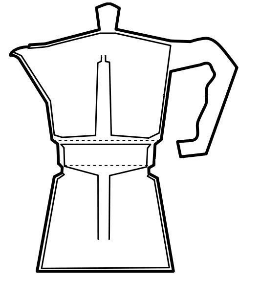
BAG COFFEE:
How is it possible for some commercial establishments to make 30, or more, cups of coffee at one time? They steep good coffee, in a bag, using the right temperature water. If it is so simple, then why doesn't anyone offer "coffee bags", for individual cups, like teabags? The truth is, that coffee-bags are available, but they make poor coffee because storing them like teabags allows flavors to evaporate & deteriorate in the air; the pre-ground coffee loses flavor quicker than whole beans; and the paper tea bags absorb some flavors. Can these problems be circumvented? YES! Purchase our fillable tea bags and fill your own with freshly ground coffee...and use them promptly. Our fillable bags are inexpensive, and are not made of paper, so flavors are not lost into the material.
EXPRESSO MACHINES:
The science & operation of these machines deserve their own section, but they are in the same class of positive or negative pressure brewers like the Aeropress & siphon machines. That is, you can make really full strength espresso or dilute the brew down to average coffee strength.
NOT COVERED HERE:
Methods that involve boiling coffee, or leaving the grounds in the coffee for an extended period of time...such as Percolators, Turkish Coffee or "Cowboy Coffee" (which is just coffee & water in a pot, on top of a fire. We don't recommend these brewing methods unless you have, somehow, acquired a taste for them as your favorite. Unfortunatly, boiling coffee changes its flavor and causes a loss of aromatics out into the air. Then leaving the grounds in the hot water foror too long (& brewing in water that is too hot) will extract bitter &/or astringent flavors into the brew.
Fillable Teabag Heat Sealers
These fillable tea bag heat sealers are the best option for sealing fillable tea bags or cachets. Fo..
$0.00 Ex Tax: $0.00
Aeropress Permanent Filter, Bundle (2, min)
If you use an AeroPress to make your coffee, a permanent filter will give you a better tasting coffe..
$4.99 $5.99 Ex Tax: $4.99
Fillable Teabags: Heatseal, Drawstring or Foldover; Tea-clips, etc
These fillable, tea bags are great for brewing of individual cups of coffee or tea from your own mix..
$0.00 Ex Tax: $0.00
French Press, 27 Ounce
The Best Coffee!Designed to capture concentrated flavors and prepare coffee in its "purest" for..
$19.95 $21.95 Ex Tax: $19.95
Vietnamese Coffee Press ("Phin")
Vietnamese coffee derives from French drip style. It tends to be a dark, strong brew that is midway..
$9.99 $11.98 Ex Tax: $9.99
WWW Butane Burner for Vac Pots
This high-quality stainless steel & ceramic butane burner replaces alcohol lamps in siphon coffe..
$54.99 $59.99 Ex Tax: $54.99
WWW Moka Pot, in Stainless Steel (2-9 x 2 oz espresso cups)
Versatile Coffee Maker Made Modern!The traditional Moka Pot, invented in Italy, is often describ..
$29.99 $34.99 Ex Tax: $29.99
WWW Permanent Filter for Siphon Coffee-Makers
This high-quality stainless steel filter, spring & clip assembly eliminates the need for cloth f..
$12.99 $15.99 Ex Tax: $12.99
WWW Classic Siphon Coffee Makers
Outrageously good coffee can be yours with these old-fashioned, but brand-new, Hi-temp glass, siph..
$59.99 $69.99 Ex Tax: $59.99

